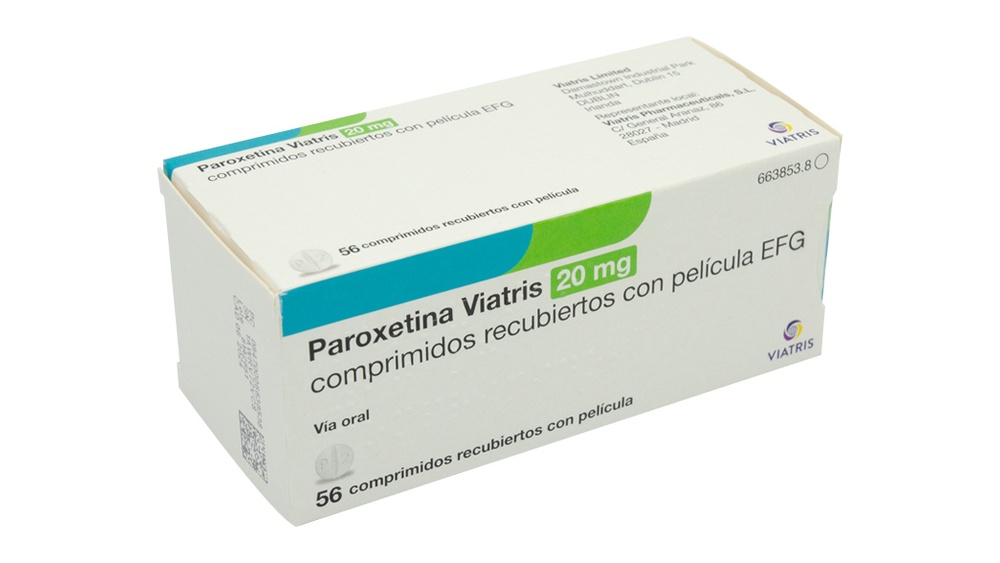

PAROXETINA TARBIS 20 mg COMPRIMIDOS REVESTIDOS POR PELÍCULA

Pergunte a um médico sobre a prescrição de PAROXETINA TARBIS 20 mg COMPRIMIDOS REVESTIDOS POR PELÍCULA

Como usar PAROXETINA TARBIS 20 mg COMPRIMIDOS REVESTIDOS POR PELÍCULA
Introdução
Prospecto: informação para opaciente
Paroxetina Tarbis 20 mg comprimidos revestidos com película EFG
Paroxetina (hidrocloruro)
Leia todo o prospecto detenidamente antes de começar a tomareste medicamento, porque contém informações importantes para si.
- Conserva este prospecto, porque pode ter que voltar a lê-lo.
- Se tiver alguma dúvida, consulte o seu médico ou farmacêutico.
- Este medicamento foi-lhe prescrito apenas para si, e não deve dá-lo a outras pessoas, mesmo que tenham os mesmos sintomas que si, porque pode prejudicá-las.
- Se experimentar efeitos adversos, consulte o seu médico ou farmacêutico, mesmo que se trate de efeitos adversos que não aparecem neste prospecto. Ver seção 4.
Conteúdo do prospecto
- O que é Paroxetina TARBIS e para que é utilizado
- O que precisa saber antes de começar a tomar Paroxetina TARBIS
- Como tomar Paroxetina TARBIS
- Posíveis efeitos adversos
- Conservação de Paroxetina TARBIS
- Conteúdo do envase e informação adicional
1. O que é Paroxetina TARBIS e para que é utilizado
Paroxetina TARBIS 20 mg pertence ao grupo de medicamentos denominados antidepresivos e actua sobre o sistema nervoso central.
Paroxetina TARBIS está indicado no:
Tratamento da depressão
Tratamento dos transtornos obsessivo-compulsivos
Tratamento do transtorno de ansiedade
Tratamento da fobia social
Tratamento do transtorno de ansiedade generalizada.
2. O que precisa saber antes de começar a tomar Paroxetina TARBIS
Não tome Paroxetina TARBIS
- se é alérgico ao princípio ativo paroxetina ou a qualquer um dos outros componentes deste medicamento (incluídos na seção 6).
- se está sendo tratado com um medicamento denominado tioridazina ou com pimozida ou bem com um tipo de medicamentos para o tratamento da depressão denominados inibidores do enzima MAO (IMAO) ou se esteve sob esse tratamento nas duas últimas semanas.
Advertências e precauções
Consulte o seu médico ou farmacêutico antes de começar a tomar Paroxetina TARBIS
- Se padece algum problema nos rins, fígado ou coração
- Se teve episódios maníacos
- Se padece epilepsia ou se apresenta convulsões
- Se padece diabetes
- Se padece alguma doença que produz tensão ocular elevada (glaucoma)
- Se tem hematomas ou sangra com facilidade ou está sendo tratado com algum medicamento que possa aumentar a hemorragia, ou se está grávida (ver «Gravidez, lactação e fertilidade»)
- Se está tomando neurolépticos (para o tratamento de doenças mentais)
- Se está tomando algum produto que contenha erva-de-São-João.
- Se está grávida, se acredita que está grávida ou se planeia ficar grávida, assim como se está em período de amamentação.
Observou-se um aumento do risco de fracturas ósseas em pacientes tratados com este tipo de medicamentos.
Alguns medicamentos do grupo ao qual pertence Paroxetina TARBIS (chamados ISRS/IRSN) podem causar sintomas de disfunção sexual (ver seção 4). Em alguns casos, esses sintomas persistem após a suspensão do tratamento.
Tenha especial cuidado com paroxetina se tem mais de 65 anos de idade porque este medicamento pode reduzir a quantidade de sódio que há no sangue e causar sonolência e fraqueza muscular. Se tiver esses sintomas, por favor, consulte o seu médico o mais rápido possível.
Pensamentos suicidas e piora da sua depressão ou transtorno de ansiedade
Se se encontra deprimido e/ou sofre um transtorno de ansiedade, pode em algumas ocasiões ter pensamentos de autolesão ou de suicídio. Esses podem ir aumentando ao tomar antidepresivos pela primeira vez, posto que todos esses medicamentos requerem um tempo para começar a fazer efeito, geralmente ao redor de duas semanas, embora em alguns casos pudesse ser maior o tempo.
Seria mais propenso a ter esse tipo de pensamentos:
- Se previamente teve pensamentos de autolesão ou de suicídio.
- Se é um adulto jovem. Informação de ensaios clínicos demonstrou um aumento do risco de condutas suicidas em adultos jovens (menores de 25 anos) com doenças psiquiátricas que foram tratados com um antidepresivo.
Se em qualquer momento tiver pensamentos de autolesão ou de suicídio, contacte o seu médico ou dirija-se diretamente a um hospital.
Pode ser de ajuda para si dizer a um parente ou um amigo que está deprimido ou que tem um transtorno de ansiedade e pedir-lhe que leia este prospecto. Pode perguntar-lhes se acham que a sua depressão ou transtorno de ansiedade piorou, ou se estão preocupados com mudanças no seu comportamento.
Crianças e adolescentes menores de 18 anos de idade
Paroxetina não deve ser utilizada normalmente no tratamento de crianças e adolescentes menores de 18 anos. Ao mesmo tempo, deve saber que em pacientes menores de 18 anos existe um maior risco de efeitos adversos como tentativas de suicídio, ideias de suicídio e hostilidade (predominantemente agressão, comportamento de confrontação e irritação) quando ingerem esta classe de medicamentos. Apesar disso, o médico que lhe corresponda pode prescrever paroxetina a pacientes menores de 18 anos quando decidir que é o mais conveniente para o paciente. Se o médico que lhe corresponda prescreveu paroxetina a um paciente menor de 18 anos e deseja discutir esta decisão, por favor, volte ao seu médico. Deve informar o seu médico se algum dos sintomas que se detalham a seguir progride ou experimenta complicações quando pacientes menores de 18 anos estão tomando paroxetina. Ao mesmo tempo, os efeitos a longo prazo porquanto à segurança se refere e relativos ao crescimento, à maturidade e ao desenvolvimento cognitivo e comportamental de paroxetina neste grupo de idade ainda não foram demonstrados.
Uso de Paroxetina TARBIS com outros medicamentos
Comunique ao seu médico ou farmacêutico se está tomando, tomou recentemente ou pode ter que tomar qualquer outro medicamento.
Especialmente Paroxetina TARBIS pode modificar o efeito dos seguintes medicamentos:
- outros antidepresivos
- aqueles para tratar doenças mentais (neurolépticos)
- aqueles para tratar a epilepsia
- lítio, que se utiliza para o tratamento de manias
- cimetidina (para o tratamento de molestias gástricas)
- prociclidina, para o tratamento da doença de Parkinson
- aqueles que contêm triptófano
- aqueles que possam aumentar o risco de aparecimento de hemorragias ou que alterem a coagulação sanguínea (p. ex. anticoagulantes orais, ácido acetilsalicílico e outros)
- alguns medicamentos que se utilizam para o tratamento de pacientes que têm latidos irregulares no coração (arritmias)
- metoprolol, que se usa para o tratamento da tensão alta, de latidos irregulares do coração (arritmias) e da angina.
- Antimigrañosos
- Tramadol (utilizado para a dor)
- Antibacterianos (lizenolid)
- Inibidores do metabolismo
Toma de Paroxetina TARBIS com alimentos, bebidas e álcool:
Como com todos os medicamentos deste tipo, é aconselhável evitar o consumo de álcool enquanto estiver tomando paroxetina.
Tome o seu medicamento pela manhã, preferivelmente com o café da manhã. Os comprimidos devem ser engolidos inteiros, com água e, preferivelmente, com alimentos. Os comprimidos não devem ser mastigados.
Gravidez, lactação e fertilidade
Se tomar paroxetina na etapa final da gravidez pode produzir-se um maior risco de sangramento vaginal abundante pouco após o parto, especialmente se tem antecedentes de alterações hemorrágicas. O seu médico ou parteira devem saber que está tomando paroxetina para poder aconselhá-lo.
Se está grávida ou em período de amamentação, acredita que possa estar grávida ou tem intenção de ficar grávida, consulte o seu médico ou farmacêutico antes de utilizar este medicamento.
Consulte o seu médico ou farmacêutico antes de tomar um medicamento. Não tome paroxetina enquanto estiver grávida ou em período de amamentação, a não ser que se lo aconselhe o seu médico. Comunique ao seu médico imediatamente se descobrir que está grávida, ou se planeia ficar grávida. O seu médico poderia recomendar interromper gradualmente o tratamento com Paroxetina TARBIS ou continuar com o mesmo. Alguns estudos sugeriram um possível aumento no risco de defeitos cardíacos em recém-nascidos cujas mães receberam Paroxetina TARBIS nos primeiros meses de gravidez. Esses estudos mostraram que menos de 2% das crianças cujas mães receberam paroxetina no início da gravidez tiveram algum problema cardíaco, em comparação com o 1% observado no resto da população geral.
Certeza de que a sua parteira e/ou médico saiba que está tomando Paroxetina TARBIS. Quando se tomam durante a gravidez, particularmente nos últimos 3 meses da gravidez, os medicamentos como Paroxetina TARBIS podem aumentar o risco de uma doença grave nos bebês, chamada hipertensão pulmonar persistente do recém-nascido (HPPN), o que faz com que o bebê respire mais rápido e se ponha de um cor azul. Esses sintomas normalmente começam durante as primeiras 24 horas após o nascimento do bebê. Se isso lhe acontecer ao seu bebê, contacte imediatamente com a sua parteira e/ou médico.
Demonstrou-se que paroxetina reduz a qualidade do esperma em estudos com animais. Teoricamente, isso poderia afetar a fertilidade, mas o impacto na fertilidade humana não foi observado até agora.
Condução e uso de máquinas
Durante o tratamento com Paroxetina TARBIS pode que se sinta sonolento ou mareado. Não conduza nem maneje ferramentas ou máquinas até que saiba como lhe afeta o tratamento com Paroxetina Tarbis.
Paroxetina TARBIS contém lecitina de soja.
Este medicamento contém lecitina de soja. Não deve ser utilizado em caso de alergia ao amendoim ou à soja.
3. Como tomar Paroxetina TARBIS
Siga exatamente as instruções de administração deste medicamento indicadas pelo seu médico.
Em caso de dúvida, consulte novamente o seu médico ou farmacêutico.
Lembre-se de tomar o seu medicamento.
O seu médico lhe indicará se deve incrementar ou reduzir a dosagem do medicamento durante o período de tratamento, assim como a duração do mesmo.
Recomenda-se administrar Paroxetina TARBIS 20 mg uma vez ao dia, pela manhã, com o café da manhã. Os comprimidos devem ser engolidos inteiros, com água e, preferivelmente, com alimentos. Os comprimidos não devem ser mastigados.
Deve continuar tomando o seu medicamento mesmo que não note melhoria, porque podem ser necessárias várias semanas para que o medicamento comece a fazer efeito.
Adultos:
Depressão
A dosagem recomendada é de 1 comprimido (20 mg) ao dia em adultos, podendo aumentar a dosagem até 50 mg ao dia.
Transtorno obsessivo-compulsivo
A dosagem recomendada é de 2 comprimidos (40 mg) ao dia, devendo iniciar o tratamento com 20 mg ao dia, até um máximo de 60 mg ao dia.
Transtorno de ansiedade
A dosagem recomendada é de 2 comprimidos (40 mg) ao dia, devendo iniciar o tratamento com 10 mg ao dia, até um máximo de 60 mg ao dia.
Fobia social
A dosagem recomendada é de 1 comprimido (20 mg) ao dia em adultos, podendo aumentar a dosagem até 50 mg ao dia.
Transtorno de ansiedade generalizada
A dosagem recomendada é de 1 comprimido (20 mg) ao dia, podendo aumentar a dosagem até 50 mg ao dia.
Pacientes de idade avançada
As dosagens iniciais recomendadas são as mesmas que para adultos. Neste grupo de pacientes, a dosagem máxima é de 40 mg ao dia.
Crianças
Não se recomenda o emprego de paroxetina em crianças menores de 18 anos, (ver apartado 2: Antes de tomar Paroxetina TARBIS).
Pacientes com insuficiência renal ou hepática
Se padece problemas nos rins ou fígado, deve tomar dosagens mais pequenas que as habituais. Informe o seu médico se tem alguma alteração dos rins ou do fígado antes de começar o tratamento.
Se estima que a ação de Paroxetina TARBIS é demasiado forte ou débil, comunique ao seu médico ou farmacêutico.
O comprimido pode ser partido em doses iguais.
Se você tomar mais Paroxetina TARBIS do que deve
Em caso de sobredosagem ou ingestão acidental, consulte imediatamente o seu médico ou farmacêutico ou ligue para o Serviço de Informação Toxicológica, telefone: 91 562 04 20, indicando o medicamento e a quantidade utilizada.
Siga a pauta posológica fixada pelo seu médico. É pouco provável que a ingestão de mais de uma dosagem seja perigrosa, mesmo que se consuma todo o conteúdo de um envase. Em caso de que ocorra, acuda ao seu médico sem demora, ou ponha-se em contacto com o serviço de urgências do hospital mais próximo.
O tratamento compreende as medidas gerais habituais utilizadas frente à sobredosagem por qualquer antidepresivo. Proceder-se-á ao esvaziamento do conteúdo gástrico mediante a indução do vómito, o lavado gástrico ou ambos. Após a evacuação gástrica, são administrados de 20 a 30 gramas de carvão ativado cada 4 - 6 horas durante as primeiras 24 horas após a ingestão. Assim como, é recomendado tratamento conservador com vigilância das constantes vitais e observação do enfermo.
Se esquecer de tomar Paroxetina TARBIS
Não tome uma dosagem dupla para compensar as dosagens esquecidas.
Se esquecer de tomar Paroxetina TARBIS, tome-o assim que se lembrar e, no dia seguinte, tome a sua dosagem habitual à hora que corresponda.
Se durante todo o dia esquecer de tomar Paroxetina TARBIS, NÃO tome uma dosagem dupla no dia seguinte.
Se interromper o tratamento com Paroxetina TARBIS
Se se interromper bruscamente o tratamento com paroxetina, podem aparecer alguns transtornos devidos à retirada, tais como mareio, alterações dos sentidos, dor de cabeça, alterações do sono, agitação ou ansiedade, náuseas e sudorese, os quais são de natureza leve a moderada e diminuem espontaneamente. O seu médico lhe aconselhará a forma de deixar o tratamento gradualmente, para evitar que lhe apareçam esses sintomas.
As crianças podem ter sintomas adicionais quando se está interrompendo o tratamento, como dor abdominal, nervosismo e mudanças de humor.
Se tiver alguma outra dúvida sobre o uso deste medicamento, pergunte ao seu médico ou farmacêutico.
4. Efeitos adversos possíveis
Assim como todos os medicamentos, a paroxetina pode ter efeitos adversos, embora nem todas as pessoas os sofram.
Alguns pacientes podem experimentar esses efeitos durante o tratamento ou ao interrompê-lo.
Efeitos adversos possíveis durante o tratamento:
Algumas pessoas podem ser alérgicas a alguns medicamentos, embora ocorram em muito raras ocasiões (pode afetar menos de 1 em cada 10.000 pacientes). Se você experimentar algum dos seguintes sintomas ao tomar paroxetina, comunique-se imediatamente ao seu médico ou dirija-se ao hospital mais próximo:
- - inchaço do rosto, pálpebras, lábios, boca ou língua
- - erupções cutâneas ou urticária (coceira na pele) em qualquer parte do corpo
- - dificuldade para respirar ou engolir
Se for observado qualquer efeito adverso descrito a seguir, que possa ou não estar relacionado à paroxetina, consulte seu médico ou farmacêutico.
Os efeitos adversos que podem aparecer de forma muito frequente (podem afetar mais de 1 em cada 10 pacientes) ao tomar Paroxetina TARBIS são:
- náuseas. Este efeito pode ser reduzido tomando o medicamento pela manhã, após o café da manhã
- disfunção sexual (falta de orgasmo, e nos homens ereção e ejaculação anormais)
Os seguintes efeitos adversos podem ser frequentes (podem afetar entre 1 e 10 em cada 100 pacientes):
- - diminuição do apetite
- - insônia (falta de sono) ou sonolência
- - tontura, tremor
- - agitação
- - visão borrada
- - bocejo
- - secura da boca, diarreia, constipação
- - sudorese, fraqueza
- - ganho de peso
Os efeitos adversos que podem aparecer de forma pouco frequente (podem afetar entre 1 e 10 em cada 1.000 pacientes) durante o tratamento com Paroxetina TARBIS incluem:
- equimose (coloração violeta que se produz por acúmulo de sangue debaixo da pele), sangramento de mucosas
- confusão
- alucinações
- efeitos extrapiramidais (transtornos do movimento e da coordenação)
- taquicardia sinusal (alteração do ritmo do coração)
- aumentos ou diminuições transitórios na tensão arterial, geralmente em pacientes com tensão alta ou ansiedade
- erupções cutâneas (manchas na pele), coceira na pele
- retenção urinária
- diminuição da contagem de glóbulos brancos
Os efeitos adversos que podem aparecer de forma rara (podem afetar entre 1 e 10 em cada 10.000 pacientes) durante o tratamento com Paroxetina TARBIS incluem:
- hiponatremia (diminuição da quantidade de sódio no sangue), especialmente em pessoas idosas ou que apresentam o síndrome de secreção inadequada de hormona antidiurética (SIHAD), que pode dar lugar a sintomas como fraqueza e sonolência (sensação de sono).
- convulsões
- reações maníacas (de euforia)
- ansiedade
- ataques de pânico
- pérdida de personalidade
- bradicardia (diminuição do ritmo do coração)
- aumento das enzimas hepáticas
- galactorreia (secreção abundante ou excessiva de leite materno)
- dor muscular e das articulações sensação de inquietude e necessidade de se mover denominada acatisia (incapacidade de permanecer sentado, necessidade de andar de um lado para o outro, de alternar o apoio de um pé para o outro).
Os efeitos adversos que podem aparecer de forma muito rara (podem afetar menos de 1 em cada 10.000 pacientes) são:
- síndrome serotoninérgico; os sintomas podem incluir agitação, confusão, diaforese (sudorese anormal), alucinações, hiperreflexia (aumento na resposta dos reflexos), mioclonia (movimentos involuntários), escalofríos, taquicardia e tremor
- efeitos no fígado, tais como hepatitis (inflamação do fígado), algumas vezes relacionados com icterícia (coloração amarelada da pele e mucosas) e/ou insuficiência hepática
- fotosensibilidade (sensibilidade à luz solar)
- síndrome de secreção inadequada de hormona antidiurética (SIHAD) (uma hormona cujo excesso pode produzir retenção de líquidos e água, dando lugar a cansaço, fraqueza ou confusão)
- glaucoma agudo (tensão alta no interior do olho)
- edema periférico (retenção de líquidos nas extremidades)
- sangramento da mucosa do estômago
- trombocitopenia (diminuição da quantidade de plaquetas no sangue)
- reações alérgicas (incluindo urticária e angioedema)
- priapismo (ereção anormal e prolongada do pênis)
Os efeitos adversos que podem aparecer com frequência não conhecida são:
- agressividade
- rangido de dentes
- inflamação do cólon (que causa diarreia)
- Sangramento vaginal abundante pouco após o parto (hemorragia pós-parto), ver «Gravidez»1 na seção 2 para mais informações.
Efeitos adversos possíveis ao interromper o tratamento:
Estudos realizados mostram que 3 em cada 10 pessoas relataram ter sintomas ao interromper o tratamento com paroxetina, em comparação com 2 em cada 10 pacientes ao interromper o tratamento com placebo. É mais provável que esses sintomas apareçam se você tomou paroxetina por muito tempo, está em uma etapa de aumento da dose ou se a dose for diminuída muito rapidamente. Na maioria dos casos, os sintomas desaparecem por si mesmos em duas semanas.
Ao interromper o tratamento com paroxetina, seu médico indicará que o faça de forma gradual, desta forma se reduzirá a possibilidade de ter efeitos adversos. Consulte seu médico se experimentar efeitos adversos graves ao interromper o tratamento com paroxetina, pode ser que seu médico recomende continuar com o tratamento e reduzi-lo posteriormente de uma forma mais lenta. Se você experimentar algum efeito adverso, não significa que não vá poder interromper o tratamento.
Entre os efeitos adversos que podem aparecer mais frequentemente ao interromper o tratamento são:
- tontura, instabilidade emocional
- alterações sensoriais, incluindo sensação de picadas, queimadura e, com menos frequência, sensações do tipo choque elétrico (mesmo na cabeça)
- alterações do sono (incluindo sonhos muito vividos, pesadelos, insônia)
- ansiedade
- dor de cabeça
Entre os efeitos adversos que podem aparecer com menos frequência ao interromper o tratamento são:
- - náuseas
- - sudorese (incluindo sudorese noturna)
- - agitação
- - tremor
- - confusão
- - instabilidade emocional
- - alterações visuais
- - palpitações
- - diarreia
- - irritabilidade
Os efeitos adversos que com maior frequência se podem observar em crianças e adolescentes menores de 18 anos são:
- Diminuição do apetite
- Tremor (estremecimento incontrolável)
- Sudorese anormal
- Hiperatividade
- Comportamento hostil/desamistoso (principalmente em crianças menores de 12 anos com obsessões e transtornos compulsivos)
- Agitação
- Emoções instáveis, incluindo choro, mudanças de humor, tentativa de autolesionar-se, pensamentos e tentativas de suicídio (ocorreram principalmente em estudos em adolescentes com depressão maior).
Os efeitos adversos adicionais que se observam de forma frequente em crianças e adolescentes menores de 18 anos que interrompem o tratamento com paroxetina são: emoções instáveis (incluindo choro, mudanças de humor, tentativa de autolesionar-se, pensamentos e tentativas de suicídio), tonturas, náuseas, dor abdominal e nervosismo.
Se algum desses sintomas começar a ser incômodo ou piorar, comunique-se ao seu médico.
Comunicação de efeitos adversos
Se você experimentar qualquer tipo de efeitos adversos, consulte seu médico ou farmacêutico, mesmo que se trate de possíveis efeitos adversos que não aparecem neste prospecto. Você também pode comunicá-los diretamente através do Sistema Espanhol de Farmacovigilância de Medicamentos de Uso Humano: https://www.notificaRAM.es. Mediante a comunicação de efeitos adversos, você pode contribuir para fornecer mais informações sobre a segurança deste medicamento.
5. Conservação de Paroxetina TARBIS
Mantenha este medicamento fora da vista e do alcance das crianças.
Não utilize Paroxetina TARBIS após a data de validade que aparece no envase após CAD. A data de validade é o último dia do mês que se indica.
Não se requerem condições especiais de conservação.
Os medicamentos não devem ser jogados nos deságues ou na lixeira. Deposite os envases e os medicamentos que não precisa no Ponto SIGRE da farmácia. Em caso de dúvida, pergunte ao seu farmacêutico como se livrar dos envases e dos medicamentos que não precisa. Desta forma, você ajudará a proteger o meio ambiente.
6. Conteúdo do envase e informações adicionais
Composição de Paroxetina TARBIS
- O princípio ativo é paroxetina na forma de hidrocloruro. Cada comprimido contém 20 mg de paroxetina.
- Os demais componentes (excipientes) são: estearato de magnésio, amido glicolato sódico de batata, manitol (E-421), celulose microcristalina, polimetacrilato, álcool polivinílico parcialmente hidrolisado, dióxido de titânio (E-171), talco, lecitina de soja (E-322), goma xantana (E-415).
Aspecto do produto e conteúdo do envase
Paroxetina TARBIS 20 mg se apresenta na forma de comprimidos revestidos com película, circulares, biconvexos, ranurados em uma face, de cor branca ou branco-acinzentada.
Se apresenta em envases contendo 14, 28, 56 e 500 (envase clínico) comprimidos.
Pode ser que apenas alguns tamanhos de envases sejam comercializados.
Titular da autorização de comercialização e responsável pela fabricação
Titular:
Tarbis Farma, S.L.
Gran Vía Carlos III, 94
08028 Barcelona (Espanha)
Responsável pela fabricação:
FERRER INTERNACIONAL, S.A.
Joan Buscallà, 1-9
08173 Sant Cugat del Vallès (Barcelona)
Espanha
Data da última revisão deste prospecto:Outubro 2023
A informação detalhada e atualizada deste medicamento está disponível na página Web da Agência Espanhola de Medicamentos e Produtos Sanitários (AEMPS) http://www.aemps.gob.es/

Quanto custa o PAROXETINA TARBIS 20 mg COMPRIMIDOS REVESTIDOS POR PELÍCULA em Espanha em 2025?
O preço médio do PAROXETINA TARBIS 20 mg COMPRIMIDOS REVESTIDOS POR PELÍCULA em dezembro de 2025 é de cerca de 3.04 EUR. Os valores podem variar consoante a região, a farmácia e a necessidade de receita. Confirme sempre com uma farmácia local ou fonte online para obter informações atualizadas.
- País de registo
- Preço médio em farmácia3.04 EUR
- Substância ativa
- Requer receita médicaSim
- Fabricante
- Esta informação é apenas para referência e não constitui aconselhamento médico. Consulte sempre um médico antes de tomar qualquer medicamento. A Oladoctor não se responsabiliza por decisões médicas baseadas neste conteúdo.
- Alternativas a PAROXETINA TARBIS 20 mg COMPRIMIDOS REVESTIDOS POR PELÍCULAForma farmacêutica: COMPRIMIDO, 20 mgSubstância ativa: paroxetineFabricante: Angelini Pharma Espana S.L.Requer receita médicaForma farmacêutica: SOLUÇÃO/SUSPENSÃO ORAL EM GOTAS, 33 mg de paroxetina/mlSubstância ativa: paroxetineFabricante: Angelini Pharma Espana S.L.Requer receita médicaForma farmacêutica: COMPRIMIDO, 20 mgSubstância ativa: paroxetineFabricante: Glaxosmithkline S.A.Requer receita médica
Alternativas a PAROXETINA TARBIS 20 mg COMPRIMIDOS REVESTIDOS POR PELÍCULA noutros países
As melhores alternativas com o mesmo princípio ativo e efeito terapêutico.
Alternativa a PAROXETINA TARBIS 20 mg COMPRIMIDOS REVESTIDOS POR PELÍCULA em Polónia
Alternativa a PAROXETINA TARBIS 20 mg COMPRIMIDOS REVESTIDOS POR PELÍCULA em Ukraine
Médicos online para PAROXETINA TARBIS 20 mg COMPRIMIDOS REVESTIDOS POR PELÍCULA
Avaliação de posologia, efeitos secundários, interações, contraindicações e renovação da receita de PAROXETINA TARBIS 20 mg COMPRIMIDOS REVESTIDOS POR PELÍCULA – sujeita a avaliação médica e regras locais.









